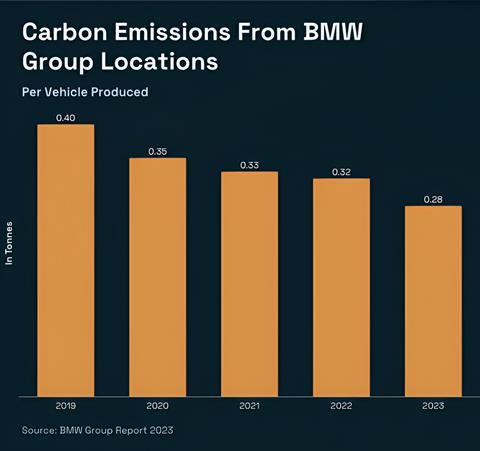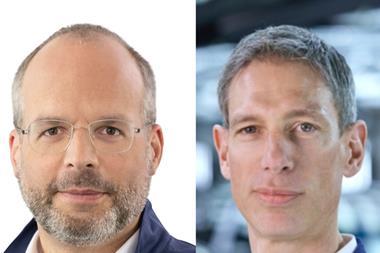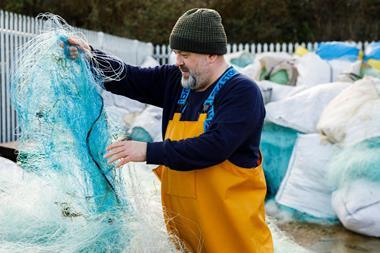BMW’s vice-president of engineering Roberto Rossetti explains the carmaker’s innovative and sustainable approach to recycling production materials to solve the problem of scarce resources, volatile commodity prices and geopolitical disruption to the supply chain
Decarbonising vehicle production and the logistics supporting it is now a priority for carmakers. Sustainability is not a new concept for BMW. It was the first automotive company to employ an environmental officer, way back in 1973. For decades, the carmaker has focused on improving efficiency, reducing emissions and decreasing fuel consumption. This effort culminated in the early 2000s with its ‘Efficient Dynamics’ programme, leading to the BMWi initiative, which first brought electric vehicles (EVs) to market. Then in 2013, the OEM introduced the i3, the first global premium EV, which was a success.


Rossetti says these four focal points are ingrained in the product development process at an early stage.
“Following the secondary first approach, we will increase the use of secondary raw materials in the future,” says Rossetti “We are taking market availability and technical feasibility into account when determining product, material and supplier requirements.” That means prioritising the use of secondary materials in all future vehicles while ensuring that quality, safety aesthetics and reliability of the products are always met with the same high standards as primary materials.
BMW i Vision Circular
BMW first introduced its i Vision Circular concept car in 2021, an electric vehicle (EV) built out of 100% recycled materials based on the OEM’s Re:think, Re:duce, Re:use and Re:cycle plan for sustainable carmaking. The vision influences current production models, with steps being taken to translate it into mainstream manufacturing.
“The purpose… is to present strong visions for the future,” says Rossetti. “The BMW i Vision Circular gives a glimpse of a compact BMW with an uncompromising focus on sustainability and circularity.”
The four-seat, pure EV offers a spacious interior within a length of around four metres. It is made according to the four Design for Circularity principles.
For series production vehicles, BMW applies the principles through different steps, according to Rossetti. That means continuously aiming to increase the percentage of secondary raw materials, focusing on materials that are compatible for recycling, and optimising vehicles for easy and quick disassembly at the end-of-life.
“Reducing CO2e emissions over the entire life cycle of a vehicle, as well as circular economy, is a significant part of our strategy”
- Roberto Rossetti, BMW
Matching the right materials
In 2025 the BMW Group will start production on its Neue Klasse vehicle platform and in doing so raise product sustainability to the next level. “Electrification, circularity and digitalisation are the central elements of this transformation,” says Rossetti.
The carmaker is focusing on mono-materials to enhance recyclability. As with any project of such major proportions there have been challenges as well as innovations, including in balancing aesthetics with sustainability. Rossetti emphasises that the OEM’s vehicles are designed with the highest standards for design and driving pleasure. “At the same time, reducing CO2e emissions over the entire life cycle of a vehicle, as well as circular economy, is a significant part of our strategy,” he says.

The recyclability of components depends primarily on the materials used and one of the current challenges BMW faces is bringing together the right materials and rethinking the connection technology. The BMW Vision Neue Klasse provides a good example, The front bumper in black is not only a contrasting design element, but it also has an increased percentage of secondary raw materials, is made of fewer component parts and allows for easier dismantling.
“The bumper covers can quickly be dismantled at the end-of-life and the different materials can be better separated in the recycling process,” Rossetti explains. “Improved material separation, in turn, helps to increase material purity in the recycling process to gain higher quality recycled materials for new components.”
Efficient disassembly and mono-material components are core measures to create more circularity and are thus essential for recyclability. However, the use of mono-materials must not lead to any negative effect on aesthetics, safety or quality in BMW’s products. “Our customers’ expectations and our brand’s overall premium approach go hand in hand with our sustainability goals – there is no room for compromises,” says Rossetti. “Finding solutions that reconcile aesthetics and sustainability is a key driver for our design and engineering team.”
One example of how BMW is acheiving this already is in the latest model generation of the BMW 1 Series. The vehilce offers the Econeer seat cover which is based on a polyethylene terephthalate (PET) mono-material. The secondary raw material content is 100% in yarn and 85% in fleece. Furthermore, disassembling the Econeer from the seat proves much easier than with conventional seat designs, according to Rossetti.
Catena-X platform sharing
To increase the use of secondary raw materials for future production BMW has to take into account market availability and technical feasibility.
“For this purpose, we specify the level of secondary raw material content in each selection process regarding product, material and supplier,” says Rossetti. “We are working closely with our suppliers to ensure that these materials are available in sufficient quantities and quality – supported by the cross-sector data ecosystem Catena-X. Market participants can use this platform to share all relevant data for the circular economy – ensuring a more efficient, circular flow of materials. In addition, we define targets and minimum levels of recyclability that need to be reached within the supply chains.”
Furthermore, the CO2e footprint of the supply chain is an essential criterion in discussions with BMW’s suppliers next to the content of secondary raw materials and the use of green electricity. The BMW Group is supporting the transformation to less carbon-intensive manufacturing processes, such as in steel production.

The carmaker’s global production network is already a model of resource efficiency. It began early to make its vehicle production more resource efficient. Year after year, it has been able to reduce the volume of waste per vehicle, as well as its water and energy consumption. “For this we rely on recycling concepts that are tailored to waste flows at the plants, the region’s legal requirements and the disposal structures available at the site,” says Rossetti.
The BMW iFactory is the carmaker’s global strategy for efficient, more environmentally-compatible and digital production. “We are taking the next step towards circular production. This includes advancing digital sorting of production waste,” says Rossetti. All these aspects will come together in the BMW Neue Klasse from 2025 onwards.
Lessons in recycling
BMW’s Recycling and Dismantling Centre (RDZ) in Munich, plays a crucial role in vehicle disassembly and material recovery. From this centre, the OEM has learned many lessons that have influenced the design of future BMW models to ensure better recyclability.
Components can be reused or recycled at the end of their service life. To achieve this, teams from the various departments of development and aftersales work closely together and share their knowledge.
Hence the RDZ keeps in continuous contact with the development department. In particular, the opportunities and challenges of dismantling components are shared with development experts. The use of mono-materials or a combination of materials that easy to recycle or segregate.
“All in all, the RDZ has repeatedly supported the development of new models, materials, and technologies by providing advances in recycling already over the past three decades,” says Rossetti.
Collaboration with suppliers, industry peers and standard-setting bodies is also important in driving meaningful change toward more sustainable sourcing throughout the automotive supply chain, which is important to BMW.
One example of where collaboration has improved recycling is in BMW’s work on aluminium wheels, which usually consist of between 20%-30% secondary material. BMW suppliers have struggled to increase this because of impurities in available feedstock but the carmaker developed a new specification for an alloy with is suppliers that can handle more impurities, allowing the secondary material content to increase to 70%.
Effective collaboration often involves cross-industry initiatives and aligning on common goalsto drive significant changes across the supply chain.
More sustainability stories from BMW
- BMW localising North American battery supply chain despite EV slowdown
- Dr Michael Nikolaides, senior vice-president for production network, supply chain management and logistics on a localised, digital supply chain
- BMW’s secret to success is preparation
M Visionary Materials Seat
The carmaker has also made significant strides in sustainable seating design, such as the award-winning M Visionary Materials Seat. This intersection of sustainable logistics and production further reflects BMW’s broader circularity goals.

As a platform for research on future materials, the award-winning BMW M Visionary Materials Seat focuses on the following key topics: Firstly, driving the use of plant-based materials, secondly, as part of ’Design for Circularity’, raising the content of secondary raw materials, and thirdly, increasing recyclability at the end of the lifecycle.
“One of our biggest lessons was the balancing, in other words, of how to model our process chain to generate missing primary data,” explains Rossetti. “The data obtained provides new insights, both in terms of today’s negative contributing factors and the design of tomorrow’s processes. This experience provides a solid foundation reaching our sustainability goals and developing innovative solutions for forward-thinking mobility.”
Sustainable material flow
Given scarce resources, volatile commodity prices, geopolitical disruption to the supply chain and regulation on decarbonisation, the circular economy is becoming central to vehicle manufacturing. Therefore, the BMW Group is taking further measures to increase the ratio of secondary raw materials in products and thus reduce dependency on primary raw materials.
An important approach is to keep materials and components in a closed loop and pursue a holistic approach to circular-oriented product design. For example, the carmaker is returning selected production scraps to suppliers to recycle the materials and incorporate them into new production processes.
Furthermore, it is strengthening its local supply chains according to the ‘local for local’ principle. “In this way,” says Rossetti, “we are continuing [in] production and supply chain to conserve resources, continuously improve energy efficiency and reduce CO2e emissions even further.”


























![Global[1]](https://d3n5uof8vony13.cloudfront.net/Pictures/web/a/d/s/global1_726550.svgz)













No comments yet